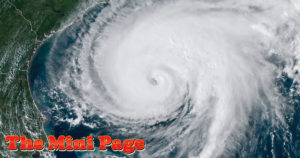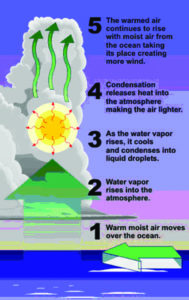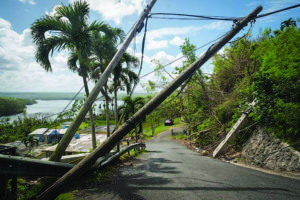
AMP | Kids is proud to partner with The Mini Page, celebrating over 50 years of providing engaging and fun learning opportunities to young readers across the country. This feature was originally syndicated in newspapers the week of June 22 – July 3, 2020. It is distributed digitally here with permission from Andrews McMeel Syndication. Enjoy and share with the young learners in your life!
According to the National Hurricane Center, the season for these sometimes dangerous storms runs from June 1 to Nov. 30 in the Atlantic Ocean, the Caribbean Sea, and the Gulf of Mexico. This week, The Mini Page learns more about hurricanes.
 Making a hurricane
Making a hurricane
These storms need the following elements to form:
- Higher than normal atmospheric pressure above the forming storm. (Atmospheric pressure is the pounds of air per square inch.)
- Warm ocean waters (at least 80 degrees).
- Moisture from the evaporating warm waters.
- Warm rising air.
- Winds meeting at the surface of the ocean.
- Winds blowing mostly from the same direction at the same speed and height.
- A wind that blows so it makes the air go in circles and spiral inward.
Hurricane stages
Weather experts carefully watch the development of storms over the ocean. They have given each stage a name, depending on the strength of the winds.
1. Tropical depression: Clouds and thunderstorms swirl in a circle with winds of up to 38 mph.
2. Tropical storm: Swirling winds reach 39 to 73 mph.
3. Hurricane: Winds reach at least 74 mph.
A hurricane brings:
- Storm surges, huge domes of water that might stretch as wide as 100 miles and be as high as 25 feet when they reach land. This is the most dangerous part of a hurricane.
- High winds destroy mobile homes and can damage buildings. As a hurricane moves inland, the winds can keep blowing and cause damage hundreds of miles from shore.
- Heavy rain and floods along the shore and inland.
- Tornadoes that add to the wind and rain damage.

Hurricane safety
- If you live near an ocean, make a hurricane plan with your family members.
- A hurricane watch means that one is possible within 36 hours. A hurricane warning means that one is expected within 24 hours.
- Evacuate immediately if you are told to leave. Have plenty of gas in the car.
- Bring in lawn furniture, garbage cans and loose objects.
- Take your pet with you if you can. If you can’t, leave out water and food.
Hurricane names
Hurricanes are given names so that we can keep track of them. When a hurricane forms, weather experts call it by a name from a special list. The names go in ABC order. There is one name for each letter except Q, U, X, Y, and Z.
This year’s names are:
- Arthur
- Bertha
- Cristobal
- Dolly
- Edouard
- Fay
- Gonzalo
- Hanna
- Isaias
- Josephine
- Kyle
- Laura
- Marco
- Nana
- Omar
- Paulette
- Rene
- Sally
- Teddy
- Vicky
- Wilfred
Resources:
On the Web:
SciJinks – How Does a Hurricane Form?
At the Library
Hurricanes! by Gail Gibbons
Eye of the Storm: NASA, Drones and the Race to Crack the Hurricane Code by Amy Cherrix
Teachers:
For standards-based activities to accompany this feature, visit Andrews McMeel Syndication. And follow The Mini Page on Facebook!
